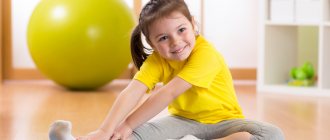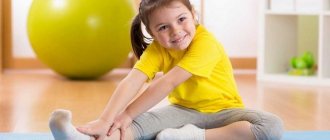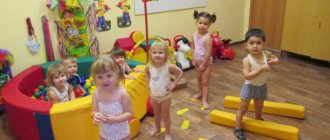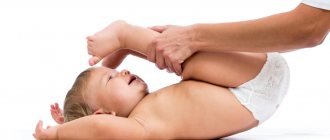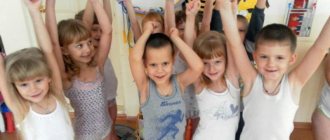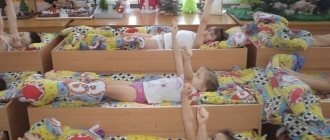Morning exercises set of exercises
For children in kindergarten, exercises are carried out on the street or in a music room, usually in a playful way. The duration of morning exercises should be no more than five minutes for the junior and middle groups, no more than ten minutes for the senior and no more than fifteen minutes for the preparatory group. You should not resort to complex exercises; exercise should be fun.
- While charging, upbeat music should sound, which will help set the kids in the right mood.
- Exercises should be interesting. You can show how animals move or tell a fascinating story about how a hedgehog visited a bear through obstacles.
- You can accompany the exercises with funny songs and rhymes.
- Pay attention to the quality of the exercises performed. In order for children to strive to do everything right, they need to be praised more often.
Features of charging for different groups:
- Junior group - four developmental exercises, running, walking. Each exercise is repeated four times. Duration: five minutes. Additional equipment: cubes, hoop houses, plumes, rattles. It is better to conduct exercises in the form of a fairy tale or ask children to perform the exercise like a cat or a bunny.
- Middle group - five general developmental exercises, repeated five or six times. Walking is complemented by exercise. You can change its tempo by clapping. Duration: six minutes. Equipment: hoops, balls, ribbons.
- Senior group - six general developmental exercises, children learn how to jump and move to the music. Charging lasts ten minutes. Equipment: gymnastic stick, pigtail cord, ball.
- Preparatory group – six general developmental exercises repeated six to eight times. Duration – fifteen minutes. The child is required to perform quality exercises. Equipment: children's dumbbells, inflatable balls, jump ropes, wall bars.
Exercises in kindergarten after sleep: with words
The exercises are carried out for seven minutes, the teacher shows the exercises and explains them.
- Sipping. Children lie on their backs, arms along the body, legs together. You need to stretch, stretching your spine.
- Let's draw a rainbow. The starting position is the same. Children need to first raise their right leg, drawing a semicircle in the air, without bending their knees. Repeat the same steps with the left leg.
- Thunder. Previous starting position. Pull your legs to your chest and clasp them with both hands. Return to starting position.
- Ships. Children lie on their stomachs, hands under the chin, legs together. You need to rise up and arch your back. Extend your arms straight forward and swing.
Cat, open your eyes
The teacher reads poems and the children do exercises.
Methods used
By the age of three or four, children have almost mastered the entire alphabet and learned to construct sentences to express their thoughts. But some people still have trouble coordinating words (for example, “one ball”). Therefore, in any case, all exercises should be clearly and understandably explained to adults. This will help get rid of speech errors.
Important! The teacher must clearly state all instructions. To make it more interesting, it is better to use rhymes and riddles.
Exercises with rhymes
Visual techniques
The image helps children better understand the world around them. That is why it is best to accompany all classes:
- pictures of animals, cartoon characters;
- step-by-step hand-drawn instructions;
- demonstration of the exercise by the teacher.
Practical technique
This method involves independent activity of children. For example, drawing, making crafts from different materials, etc. This type of activity is very important, because with the help of it, imagination and fine motor skills develop, and children learn to fantasize.
Gaming technique
He is usually accompanied by music. It helps you feel the pace and rhythm of the exercise. Musical tones help you understand when you need to change the nature of your movements. For example, calm music encourages moderate walking, while cheerful and lively music encourages running and jumping. In addition, it increases the discipline, efficiency, and attentiveness of children.
Gymnastics complex for awakening from sleep for senior groups of preschool educational institutions
